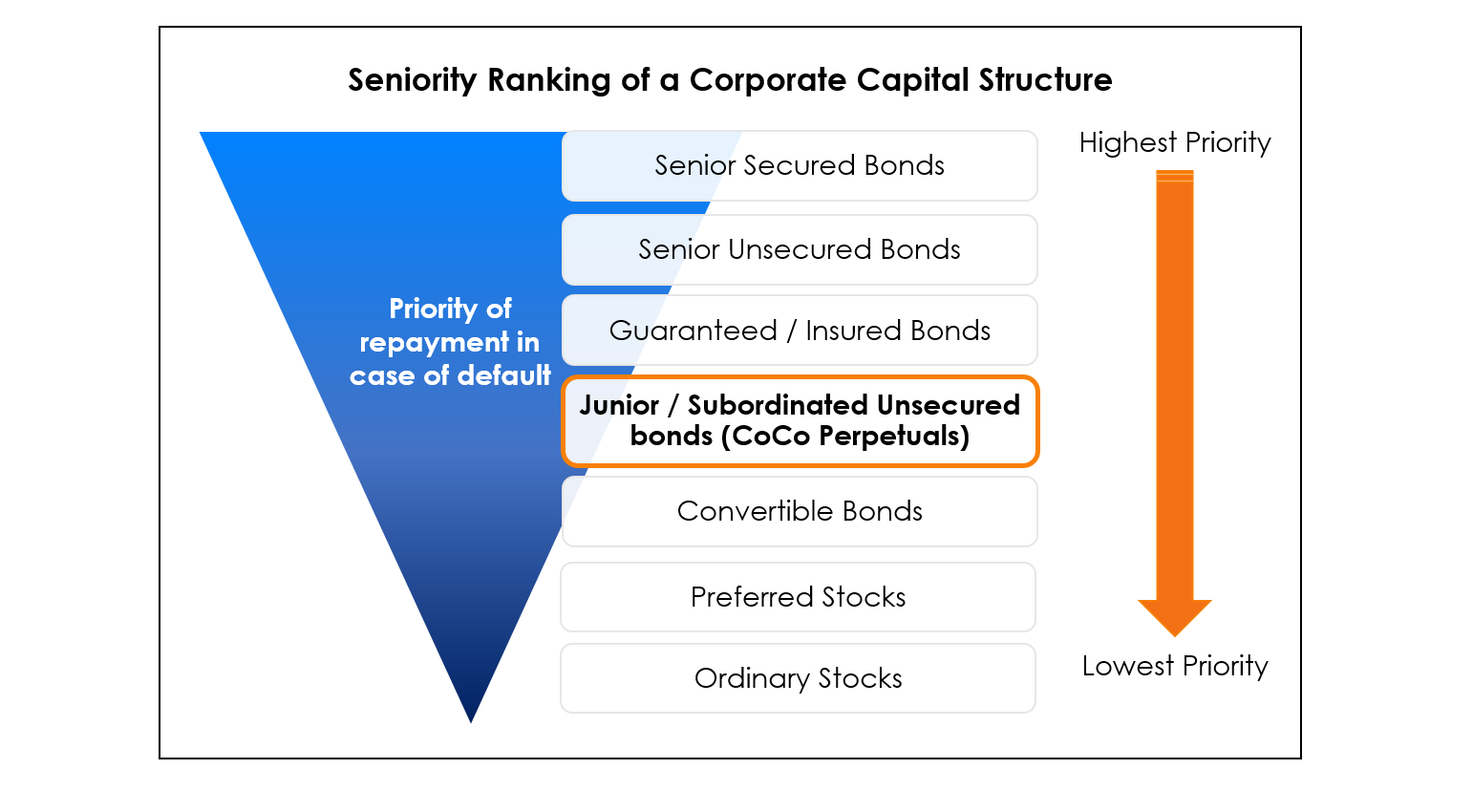This site uses cookies to provide you with a great user experience. By using BondbloX, you accept our use of cookies.
Bond Market News
Perpetual Bonds – Key Risks to Know Before Investing
May 14, 2019

Perpetual bonds have became very popular among individual investors, but the question is do you know what you are buying?
Here are some of the key risks that you should keep in mind before investing in perpetuals.
1. Redemption Uncertainty
Perpetual bonds are a unique investment that differ from other types of fixed income products in that their redemption has an element of uncertainty and typically happens at the option of the issuer. Most perpetual bonds have a structure that allows the issuer to call back the bonds or redeem them starting from a stipulated date e.g. 5 years after the issue date, and periodically e.g. 6 months thereafter. Nevertheless, redemption is dependent on market factors such as the level of interest rates, current price of the bond, the structure of the bond such as the step-up amount, as well as company-specific considerations such as the funds available for repayment.
In a market environment where interest rates have declined to levels that allow companies or banks to borrow more cheaply if they were to issue new debt, the probability of issuers exercising their option for redemption is higher. The likelihood that issuers will repay their perpetual bonds is increased when the bond terms include a step-up interest rate which comes into effect after a call date when the issuer does not exercise their option to redeem the bonds. In this case, issuers would prefer to redeem and issue new debt, which would cost them less.
It is common to see issuers call their bonds at the first call date when there is a significant step-up in coupon after, which leads many investors to assume that their bonds will always be called. Unfortunately, this is not true.
It is possible that if an issuer decides to never call their bonds, investors will only be repaid in coupons for eternity. Alternately, they can get their principal back by selling their perpetual bonds in the secondary markets, subject to market liquidity. It is important for investors to understand that the option lies with the issuer and that there can be a possibility where the perpetual will not get called on the first call date. This was the case in February 2019 when Spanish bank Banco Santander chose not to call its 6.25% contingent convertible (CoCo) perpetuals with an amount outstanding of EUR 1.5 billion. While this move took investors by surprise, it made economic sense for Santander as the floating rate coupon that kicked-in post first call date was lower vs. if it had redeemed the bonds and issued new ones.
2. Lack of Voting Rights
Most perpetual bonds are treated under accounting standards as equity in their company’s financial statements, since the structure of these bonds imitate the payment schedule of a dividend-paying stock where coupons are paid out periodically with a deferment option, and redemption is neither fixed at a certain date nor guaranteed. However, whereas holders of a company or bank’s equity have the right to vote on certain issues which require shareholder input, this privilege does not apply to bond holders including those who own perpetual bonds.
3. Subordinated Nature of Perpetual Bonds
The seniority of a bond determines the priority in which investors get repaid in the event that an issuer defaults or goes into liquidation. Fixed income and equity products can be classified according to their repayment priority, with senior secured bonds having the right to receive payment first in the event of a bankruptcy or liquidation. The priority of repayment then goes down the pyramid as seen below, until the issuer’s asset base is depleted.

Perpetual bonds typically fall under the category of subordinated bonds, such as that of CoCo bonds. CoCo bonds are classified as Additional Tier 1 (AT1) capital and are junior to Tier 2 capital, which in turn are subordinated to senior and/or secured bonds. CoCos are particularly popular among bank issuers for the purpose of adding to the capital base of the bank, helping to cushion the capital structure when leverage is high by potentially absorbing losses if there were to be a crisis situation.
What is so different about CoCo bonds?
As the name suggests, CoCo bonds can be converted into equity upon a contingent event where certain triggers are met. Currently, the most typically seen trigger is a conversion of some or all of an issuer’s perpetual bonds into its stocks at a stipulated ratio, in the event that its common equity tier 1 (CET1) capital ratio falls below a specific number.
Take HSBC 6.25% PerpNC5 as an example. Its Capital Adequacy Trigger Event is when the CET1 ratio falls below 7% and conversion is set to be within a month of the event occurrence.
HSBC 6.25% Perpetual – Bond Pricing Supplement

CoCo Conversion Trigger

CoCos have increased risk from equity conversion and the fact that they also sit lower on the repayment priority in events of liquidation. This explains why investors would demand higher yields from CoCos. Risks are compounded by the fact that conversion only occurs when the issuer has an overweight debt to equity ratio, which decreases the likelihood of repayment.
Extra precaution should be taken in evaluating the risks of perpetual bonds in light of its subordinated nature, and investors should look beyond the higher coupons and the promise of receiving coupon payments to perpetuity. Investors should analyse and understand an issuer’s cash flow position and the ability to meet financing requirements, before investing.
4. Discretionary Coupons
A feature that is often seen in CoCo perpetuals is discretionary coupons. This feature gives bond issuers the right to pay coupons at its sole discretion or choice, without being an obligation. Investors that buy into a bond with this feature have the additional risk of not receiving a coupon payment during the life of the bond. Cancelled coupon payments may or may not accumulate, meaning that investors may or may not receive the cancelled coupon payments at a later date.
Looking at the same HSBC 6.25% PerpNC5 bond, we can see that it does in fact have a discretionary coupon clause, which are non-cumulative in nature.
Discretionary Coupon

Thus, it is important for investors to review the bond prospectus (available on the BondEvalue platform), especially when investing in perpetual bonds. Fully understanding key points such as coupon resets, call schedule, seniority/payment rank, conversion triggers and discretionary coupons will help investors compare perpetual bonds effectively and make an informed investment decision.
Go back to Latest bond Market News
Related Posts:
Masala Bonds – Everything You Need to Know
December 17, 2024

New Bond Issue Process – Explained
December 13, 2024

Green Bonds – Everything You Need to Know
April 7, 2021






